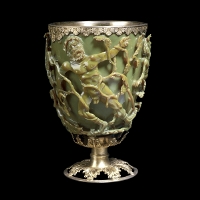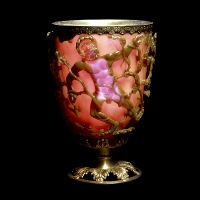The Lycurgus cup
The strong scattering properties of metallic nanoparticles is beautifully illustrated by the Lycurgus cup, fabricated in Roman times, which appears as different colours in reflection and transmission. This is due to the fact that shorter wavelength blue and green light is much more strongly scattered than red light, as explained below.


Image reproduced by kind permission of the British Museum.
The two images above both show the same cup, which was probably made in Rome in the 4th century A.D. On the left, the cup is viewed 'normally', appearing green in reflected light, while in the image on the right, the cup is illuminated from inside, and appears red when light is shone through it.
About the piece...
The scene on the cup depicts an episode from the myth of Lycurgus, a king of the Thracians (around 800 BC). A man of violent temper, he attacked Dionysos and one of his maenads, Ambrosia. Ambrosia called out to Mother Earth, who transformed her into a vine. She then coiled herself about the king, and held him captive. The cup shows this moment when Lycurgus is entrapped by the branches of the vine, while Dionysos, a Pan and a satyr torment him for his evil behaviour. It has been thought that the theme of this myth - the triumph of Dionysos over Lycurgus - might have been chosen to refer to a contemporary political event, the defeat of the emperor Licinius (reigned AD 308-24) by Constantine in AD 324.
Fabrication
The cup is also the only figural example of a type of vessel known as a 'cage-cup'. The cup was made by blowing or casting a thick glass blank. This was then cut and ground away until the figures were left in high relief. Sections of the figures are almost standing free and connected only by 'bridges' to the surface of the vessel.
Optical Properties
The unusual optical properties of the cup's glass arise due to tiny particles of gold and silver suspended in the glass, which scatter light.
References
Mendelssohn R. Larry Todd, OUP, 2005
Scherzo in E minor Alfred Publishing, 1988

